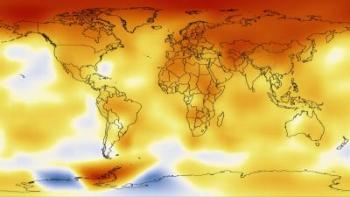According to NASA’s Goddard Institute for Space Studies (GISS), last year was tied for the second warmest year on record after 2005, the warmest year on record. If just looking at the southern hemisphere, however, 2009 proved the warmest yet recorded since record-taking began in 1880. Overall 2009 tied a total of five other years—four from the 2000s—for the second warmest on record. But, researchers say what is most important was that the past decade, from January 1st 2000 to December 31st 2009, proved the warmest on record.
“There’s always interest in the annual temperature numbers and a given year’s ranking, but the ranking often misses the point,” James Hansen, GISS director, said in a press release. “There’s substantial year-to-year variability of global temperature caused by the tropical El Nino-La Nina cycle. When we average temperature over five or ten years to minimize that variability, we find global warming is continuing unabated.”
 The map shows temperature changes for the last decade — January 2000 to December 2009 — relative to the 1951-1980 mean. Warmer areas are in red, cooler areas in blue. The largest temperature increases occurred in the Arctic and a portion of Antarctica. Map by: NASA. |
The year before last, 2008, was the coolest year of the 2000s due to a strong La Nina event that cooled the tropical Pacific Ocean, however warm temperatures made a comeback last year as the La Nina event fell back. Even an unseasonably cool December in North America did little to stem the overall warming trend in 2009.
“The contiguous 48 states cover only 1.5 percent of the world area, so the United States’ temperature does not affect the global temperature much,” Hansen explained.
While the United States, Europe, and China may have been colder than usual this winter, the Arctic and the Southern Hemisphere remained significantly warm. Climatologists have pointed out recently the importance of understanding the difference between weather (day-to-day localized events) and climate (longterm trends).
Overall GISS has measured an upward trend in the global temperature of about 0.36 degrees Fahrenheit (0.2 degrees Celsius) every ten years over the past three decades. Since 1880, temperatures have risen about 1.5 degrees Fahrenheit (0.8 degrees Celsius).
The GISS uses slightly different temperature analysis than other temperature research groups, such as the Met Office Hadley Centre in the UK, which omits temperature readings from large parts of the Arctic and Antarctic because monitoring stations are sparse. Despite these small differences both GISS and Met Office Hadley Centre record that the 2000s was clearly the warmest decade on record.
“There’s a contradiction between the results shown here and popular perceptions about climate trends,” Hansen said. “In the last decade, global warming has not stopped.”
Related articles
Current decade is the warmest on record
(12/08/2009) As 192 countries meet in Copenhagen to wrangle out a complex and at times sticky agreement to combat climate change, the World Meteorological Organization (WMO) has released new evidence that the world is undergoing warming. According to the WMO the current decade is likely the warmest on record.
Record global ocean temperature in July
(08/19/2009) The world’s ocean surface temperature was the warmest on record for July, breaking the previous record set in 1998, reports NOAA’s National Climatic Data Center. At 62.56°F (16.99°C), ocean temperatures were 1.06°F (0.59°C) above the 20th century average.
Earth already committed to 2.4-degree C rise from climate change
(09/15/2008) As of 2005 the Earth was already committed to rise of global mean temperatures by 2.4°C (4.3°F), concludes a new study published in the journal Proceedings of the National Academy of Sciences (PNAS). The conclusion is significant because the Intergovernmental Panel on Climate Change (IPCC) has warned that a rise in global temperature by 1 to 3°C will lead to catastrophic consequences, including “widespread loss of biodiversity, widespread deglaciation of the Greenland Ice Sheet, and a major reduction of area and volume of Hindu-Kush-Himalaya-Tibetan glaciers, which provide the head-waters for most major river systems of Asia.” These glaciers, predicted to shrink considerably in the next few decades, provide food and water to over two billion people.